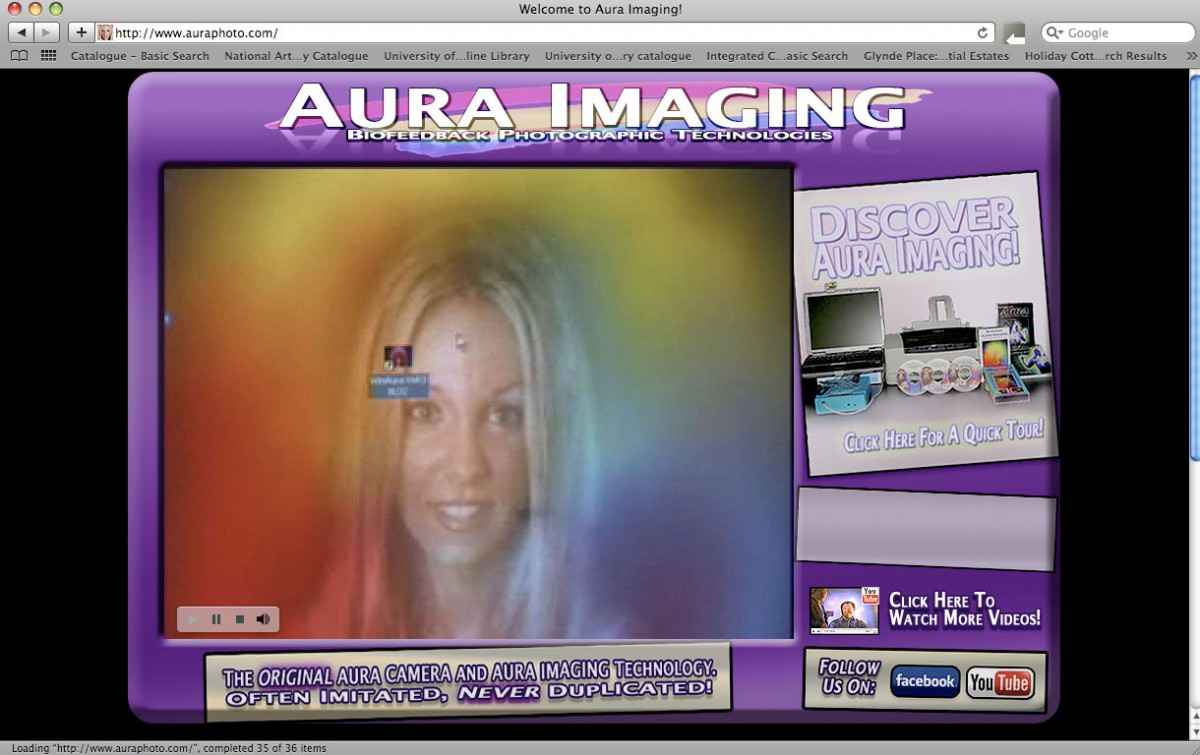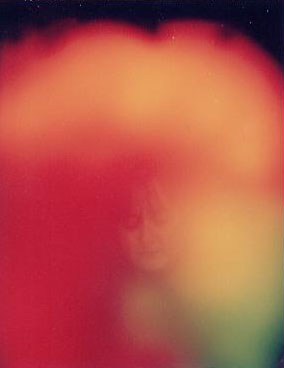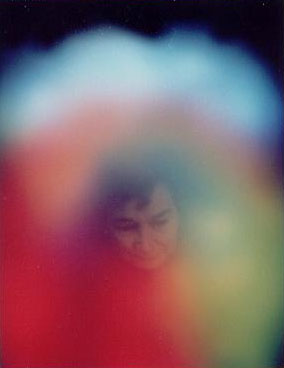Ghosts in the Machine: The aura camera was invented by the American, Guy Coggins, in the 1970s.
Ghosts in the Machine
One of numerous websites describes its function as follows:
Aura photography…is based on the understanding of modern technology combined with the information that past cultures have known for millennia. This includes Kirlian photography, electronic acupuncture, biofeedback measurements, as well as old healing methods like acupuncture, acupressure, Ayurveda, and so forth. Using this wealth of knowledge, we can create technologies that can help us view the coloured radiant Aura and allow us to open up new possibilities of perception for our inner worlds. The method our technologies use to read one’s Aura is known as “Biofeedback”, since a physical reading of one’s bio-signs is the main method of Aura analysis…Throughout history, Auras could only be seen by a gifted few. Progen has, through modern technology, given everyone the ability to see Auras.
In practical terms, the ‘biofeedback’ information is gathered using a hand sensor, and translated into ‘a radiant, colored aura field around the body’ using pre-programmed computer software. It is interpreted in relation to ‘a person’s internal make up at that moment, showing balance and well being’ through the use of a colour key. In truth, the photographs do not show the actual image of the body’s unseen energy field, but the imitation of such a field, based primarily on something called skin resistance. This is one of the physiological variables measured by a galvonometer, as part of a polygraph or ‘lie detector’, whereby an unfelt electrical current passes through the subject’s hand and detects sweat gland activity associated with nervousness.
[ms-protect-content id=”8224, 8225″]
Through the references to ancient cultures and religious traditions, and the photographs’ visual resemblance to earlier representations of auras, the colorful impressions resulting from physiological changes associated with different degrees of nervousness are framed in spiritual, rather than scientific, terms. While this misrepresentation on the part of retailers is motivated by the pursuit of profit, questions remain as to why the consumers of aura photography have been willing to accept such claims. A brief examination of earlier spirit photography may provide some answers.
The first spirit photograph was produced in Boston in 1861, when an amateur photographer, William Mumler, convinced a spiritualist acquaintance that a ghostly looking double exposure provided an objective record of the usually unseen spirit world. Spirit photography’s commercial operations grew rapidly in the USA and Europe, while the photographs also attracted the attention of some respected scientific figures.
The plausibility of the claims made for the pictures, along with those made for spiritualism more broadly, resulted in part from resemblances to advances made within mainstream science during the second half of the nineteenth-century. The spiritualist movement began when Katherine and Margaret Fox—two teenage sisters living in Rochester—claimed to have communicated with spirits of the departed through a series of raps and sounds. This was four years after Samuel Morse’s invention of telegraphy, which had made wireless communication across long geographical distances possible through its series of dots and dashes.
The discovery of radio waves in 1864, the phonograph in 1888, telephony in 1893, and the first radio broadcast in 1906, offered the means through which the human voice could be recorded and listened back to after the speaker’s death, and transmitted across long distances. As the psychical researcher Frank Podmore argued in 1902, such inventions provided both a useful resemblance to purported psychic operations, and ‘opened up the mind to unimagined possibilities beyond the physical realm.’
Photography emerged from the same context of rapid technological change, expanding the possibilities of vision beyond the realm of what the human observer could ordinarily perceive. While the invention of photomicrography in 1839 had lent permanent form to the invisibly small, the first examples of photo-telescopy in 1840 introduced wider audiences to the appearance of the astronomically distant. The instantaneous photographs produced by Muybridge and Marey opened a hitherto unseen world of rapid movement, while the invention of radiography in 1895 offered an opportunity to see through solid matter.
Spirit photography exploited the combined imaginative and scientific possibilities set in place by such developments. For James Coates, writing in a historical survey of spirit photography in 1911:
To say that the invisible cannot be photographed, even on the material plane, would be to confess ignorance of facts which are commonplace—as, for instance, to mention the application of X-ray photography to the exploration of muscles, of fractures of bone, and the internal organs. Astronomical photography affords innumerable illustrations of photographs of the invisible.
We are living through another period of technological change, as computers undertake many of the tasks once performed by machines. Viewed through the lens of early spirit photography and the analogies used to support it, we can recognise the ways in which aura photography similarly looks to this wider technological context to legitimate its own occult operations. The use of computers and sensors to create colourful pictures said to correspond to the sitter’s internal being seeks credibility through implicit parallels with the imagery produced by MRI scans and other medical imaging technologies, that use computers to translate radio waves into pictures of the body’s inner workings.
We can also think about the images in relation to a wider current of paranormal digital photography. The Web is full of sites that allow visitors to upload photographs showing supposed occult phenomena, often described by their makers in terms of ‘ectoplasm’ or ‘orbs’. In reality, it is likely that such are created when the camera’s flash reflects off raindrops, unnoticed shiny surfaces or dust particles. However, a body of new age literature has explained them as a result of paranormal forces. Many of these accounts suggest that digital cameras offer the most effective means to photograph the paranormal, due to their particular sensitivity to the light spectrum within which such phenomena are said to occur.
Any actual increase in the appearance of orbs is most likely to result from a general rise in the quantity of photographs taken due to the cheapness and ubiquity of digital photography. The fact that the Web provides an inexpensive and easy way to publish the pictures may also have contributed to the impression that more of them now exist. Yet the defenders of orb photography repeatedly fall back upon arguments and analogies rehearsed by the defenders of spirit photography more than a century earlier, but reframed in terms of digital photography: citing infrared and X-rays, and the complex operation of invisible waves, as related—and scientifically accepted—phenomena.
The reception of such photographs can be understood in relation to a variety of factors, among them, a rejection of official science as a prescriptive authoritarian narrative; a renewed interest in the occult within mass culture; and the postmodern ideologies of new age consumption. Approached through the historical lens of earlier spirit photography, however, the place of technology within these debates becomes clear, along with the ways in which scientific advances can provide an analogy to legitimate more dubious practices. Whether such fantasies indicate an imaginative form of popular engagement with changing technologies, or the ways in which ignorance continues to result in delusion and exploitation, remains open to discussion. But perhaps it is too easy to feel cynical discussing the truth of such images in black and white terms, when auras appear to be so colourful.
http://www.auraphoto.com/indexmovie.554×416.shtml
[/ms-protect-content]
Published in Photoworks issue 17
Commissioned by Photoworks



